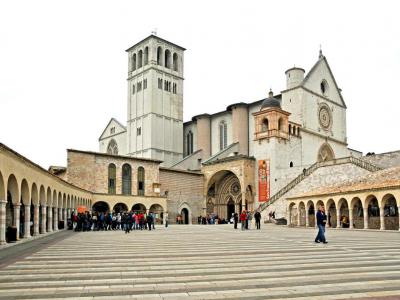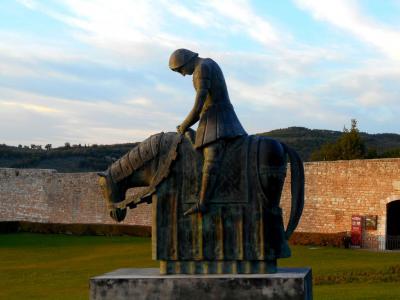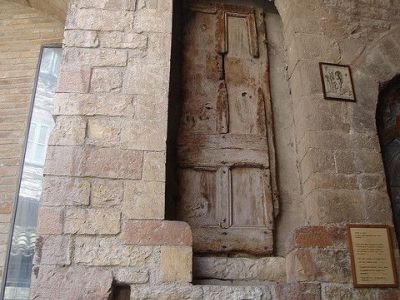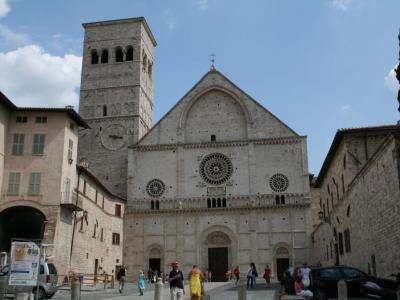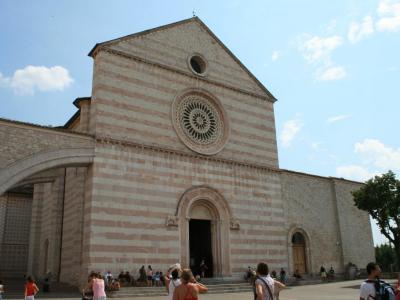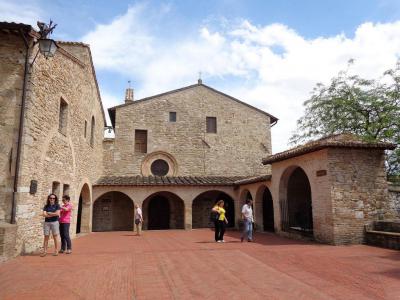St. Francis' Assisi Walking Tour (Self Guided), Assisi
A holy city for Christians, Assisi has been an eternal destination of pilgrimage since the 13th century for those venerating Saint Francis and wanting to the see where he was born, worked, died and was buried. As the birthplace of one of Catholicism’s most revered saints (and one of Italy's two saintly patrons), Assisi holds religion very close to its heart.
The entire city-sanctuary – a UNESCO World Heritage Site since 2000 – basks in the coveted status thanks to the plethora of historically significant buildings, such as the Basilica di San Francesco – the jewel in Assisi’s crown, so massive you can see it for miles around.
At some point, when the noise of steps made by the numerous monks in long brown robes and the bands of pilgrims roaming the streets fades and the town gets enveloped in an almost mystical silence, you can feel the true spirit of Saint Francis more intimately. Here are some of the places in Assisi you may wish to include in your own pilgrimage:
San Francesco Birth House – the original place where Saint Francis was born on July 5, 1182.
Cathedral of San Rufino – aka Assisi Cathedral, built atop an old Roman cistern in the 13th century; contains the fountain where both St Francis and St Clare (Chiara) were baptized.
Santa Chiara (Saint Clare) Basilica – dedicated to St Clare, St Francis’s contemporary and founder of the Order of the Poor Clares.
San Damiano Church – a tiny church marking the spot where, according to legend, St Francis first heard the voice of God telling him to “rebuild the church.”
To explore these and other sights relevant, directly or remotely, to the life of Saint Francis in Assisi, take this self-guided walking tour.
The entire city-sanctuary – a UNESCO World Heritage Site since 2000 – basks in the coveted status thanks to the plethora of historically significant buildings, such as the Basilica di San Francesco – the jewel in Assisi’s crown, so massive you can see it for miles around.
At some point, when the noise of steps made by the numerous monks in long brown robes and the bands of pilgrims roaming the streets fades and the town gets enveloped in an almost mystical silence, you can feel the true spirit of Saint Francis more intimately. Here are some of the places in Assisi you may wish to include in your own pilgrimage:
San Francesco Birth House – the original place where Saint Francis was born on July 5, 1182.
Cathedral of San Rufino – aka Assisi Cathedral, built atop an old Roman cistern in the 13th century; contains the fountain where both St Francis and St Clare (Chiara) were baptized.
Santa Chiara (Saint Clare) Basilica – dedicated to St Clare, St Francis’s contemporary and founder of the Order of the Poor Clares.
San Damiano Church – a tiny church marking the spot where, according to legend, St Francis first heard the voice of God telling him to “rebuild the church.”
To explore these and other sights relevant, directly or remotely, to the life of Saint Francis in Assisi, take this self-guided walking tour.
How it works: Download the app "GPSmyCity: Walks in 1K+ Cities" from Apple App Store or Google Play Store to your mobile phone or tablet. The app turns your mobile device into a personal tour guide and its built-in GPS navigation functions guide you from one tour stop to next. The app works offline, so no data plan is needed when traveling abroad.
St. Francis' Assisi Walking Tour Map
Guide Name: St. Francis' Assisi Walking Tour
Guide Location: Italy » Assisi (See other walking tours in Assisi)
Guide Type: Self-guided Walking Tour (Sightseeing)
# of Attractions: 6
Tour Duration: 2 Hour(s)
Travel Distance: 3.2 Km or 2 Miles
Author: leticia
Sight(s) Featured in This Guide:
Guide Location: Italy » Assisi (See other walking tours in Assisi)
Guide Type: Self-guided Walking Tour (Sightseeing)
# of Attractions: 6
Tour Duration: 2 Hour(s)
Travel Distance: 3.2 Km or 2 Miles
Author: leticia
Sight(s) Featured in This Guide:
- Basilica di San Francesco d'Assisi (Basilica of Saint Francis)
- Il Ritorno di Francesco ("The Return of Francis") Statue
- Casa natale di San Francesco (Birthplace of St. Francis)
- Cattedrale di San Rufino di Assisi (Assisi Cathedral)
- Basilica di Santa Chiara (Basilica of St. Clare)
- Chiesa di San Damiano (Church of St. Damian)
1) Basilica di San Francesco d'Assisi (Basilica of Saint Francis) (must see)
Since its construction in 1228, the Basilica of Saint Francis has held major significance as a site of Catholic pilgrimage worldwide. Aside from enshrining the body of the venerated saint beneath the high altar, its collection of paintings by Giotto is renowned for its role in Western art history, transitioning from Byzantine stylization to humanist narrative, realism, and three-dimensionality. Depicting scenes from the life of the saint and other biblical narratives, these paintings have influenced generations of artists and continue to captivate.
Architecturally, the basilica is structured in two tiers, with the Upper Church above the Lower Church. This extraordinary feat presented significant engineering challenges, which were ingeniously addressed through the use of massive arched buttressing. While the original creator remains unknown due to the destruction of original drawings in a raid by the Perugians, it is commonly attributed to Lombard masons inspired by Gothic churches in southern France. The structure's design, particularly its single-naved Upper Church, served as a model for countless Franciscan churches across Italy.
Both churches are adorned with exquisite frescoes, making them veritable artistic treasure troves. The Lower Basilica exudes a dimly lit ambiance, while the Upper one is characterized by its brightness and spaciousness. Giotto's frescoes in the Upper Church, painted when he was still in his twenties, mark him as a pivotal figure in the evolution of Western painting. Additionally, the Lower Church boasts frescoes by esteemed painters Simone Martini and Pietro Lorenzetti, alongside those by Giotto or his assistants.
Visitors should adhere to the basilica's strict dress code, which prohibits bare shoulders or knees. To avoid crowds, it is advisable to visit early or late in the day, ensuring a more serene experience amid the awe-inspiring ambiance.
Architecturally, the basilica is structured in two tiers, with the Upper Church above the Lower Church. This extraordinary feat presented significant engineering challenges, which were ingeniously addressed through the use of massive arched buttressing. While the original creator remains unknown due to the destruction of original drawings in a raid by the Perugians, it is commonly attributed to Lombard masons inspired by Gothic churches in southern France. The structure's design, particularly its single-naved Upper Church, served as a model for countless Franciscan churches across Italy.
Both churches are adorned with exquisite frescoes, making them veritable artistic treasure troves. The Lower Basilica exudes a dimly lit ambiance, while the Upper one is characterized by its brightness and spaciousness. Giotto's frescoes in the Upper Church, painted when he was still in his twenties, mark him as a pivotal figure in the evolution of Western painting. Additionally, the Lower Church boasts frescoes by esteemed painters Simone Martini and Pietro Lorenzetti, alongside those by Giotto or his assistants.
Visitors should adhere to the basilica's strict dress code, which prohibits bare shoulders or knees. To avoid crowds, it is advisable to visit early or late in the day, ensuring a more serene experience amid the awe-inspiring ambiance.
2) Il Ritorno di Francesco ("The Return of Francis") Statue
In 2005, Italian artist Norberto Proietti crafted a modern equestrian statue of Saint Francis, now standing outside his namesake Basilica. Inscribed on the bronze plaque is a quote from the "Legend of the Three Companions", describing a crucial moment in the saint's life:
– Lord, what do you want me to do?
– Go back to your city and you will be told what you must do.
At daybreak, Francis, with a renewed inner spirit, sought only to align himself with the will of God.
Throughout his life, Francis experienced many dreams. One such vision led him to aspire to become a knight and join the papal army. Following this vision, he acquired armor and a horse, setting off for Rome. However, during a stop in Spoleto, he had another dream in which God questioned his actions, urging him to serve God rather than the army.
Undoubtedly, the young Francis, filled with idealistic aspirations, feared returning to Assisi, where he might face his family's scorn for abandoning his knightly ambitions and avoiding the perils of battle. The statue portrays the future saint in a state of humility, prior to his monkhood – slouched in his saddle, head and shoulders drooping, his despondency mirrored by the demeanor of his horse.
– Lord, what do you want me to do?
– Go back to your city and you will be told what you must do.
At daybreak, Francis, with a renewed inner spirit, sought only to align himself with the will of God.
Throughout his life, Francis experienced many dreams. One such vision led him to aspire to become a knight and join the papal army. Following this vision, he acquired armor and a horse, setting off for Rome. However, during a stop in Spoleto, he had another dream in which God questioned his actions, urging him to serve God rather than the army.
Undoubtedly, the young Francis, filled with idealistic aspirations, feared returning to Assisi, where he might face his family's scorn for abandoning his knightly ambitions and avoiding the perils of battle. The statue portrays the future saint in a state of humility, prior to his monkhood – slouched in his saddle, head and shoulders drooping, his despondency mirrored by the demeanor of his horse.
3) Casa natale di San Francesco (Birthplace of St. Francis)
This is believed to be the original site where the future Saint Francis of Assisi was born on July 5, 1182. Legend has it that his birthplace was once a stable, housing oxen and donkeys, where his mother sought refuge to give birth. The inscription above the pointed arch entry attests to this history, with the property being transformed into an oratory and first documented in 1286.
The façade is dominated by a Romanesque arch, with a Gothic entry portal. Stepping inside this place of worship, especially after visiting the larger churches bustling with tourists, one immediately notices the humble, minimalist interior: simple benches along the walls and traces of 13th-14th century frescoes above the raised altar.
Outside, in a charming, intimate square, stands a modern bronze sculpture depicting Francesco's parents: his father, Pietro di Bernardone dei Moriconi, and his French mother, Pica de Bourlemont. Overlooking the square is the imposing 17th-century Chiesa Nuova (New Church) with a grand Renaissance-style façade. This church was erected in 1615 on the presumed site of Saint Francis's paternal home.
Inside the church, near the first pillar on the left, visitors can see the room where Francesco's father, a prosperous silk merchant, allegedly chained his young rebellious son in an attempt to dissuade him from a life of penitence and devotion to the poor, hoping to steer him back to the family trade. Ultimately, Francesco was released by his mother, who understood her son's calling to higher values.
The façade is dominated by a Romanesque arch, with a Gothic entry portal. Stepping inside this place of worship, especially after visiting the larger churches bustling with tourists, one immediately notices the humble, minimalist interior: simple benches along the walls and traces of 13th-14th century frescoes above the raised altar.
Outside, in a charming, intimate square, stands a modern bronze sculpture depicting Francesco's parents: his father, Pietro di Bernardone dei Moriconi, and his French mother, Pica de Bourlemont. Overlooking the square is the imposing 17th-century Chiesa Nuova (New Church) with a grand Renaissance-style façade. This church was erected in 1615 on the presumed site of Saint Francis's paternal home.
Inside the church, near the first pillar on the left, visitors can see the room where Francesco's father, a prosperous silk merchant, allegedly chained his young rebellious son in an attempt to dissuade him from a life of penitence and devotion to the poor, hoping to steer him back to the family trade. Ultimately, Francesco was released by his mother, who understood her son's calling to higher values.
4) Cattedrale di San Rufino di Assisi (Assisi Cathedral) (must see)
As you step out from the narrow streets east of the Town Hall Square, the Cathedral, or "Duomo", presents itself with its characteristic three-tiered Umbrian facade. Tradition has it that the first church on this site was built around 412 to house the remains of Saint Rufinus, Assisi's first ever bishop, martyred about 170 years earlier. Another structure was erected around 1029, with the crypt and current bell tower surviving from that period. Yet another iteration of the church, closest to the present-day one, was consecrated in 1253.
Its Romanesque portal is a masterpiece of carving, flanked by two red marble lions and adorned with lilies, foliage, faces, birds, winged crocodiles, and a pair of griffins. Look closely at the lunette above the door to spot the child being nursed, with its stern-looking parents. Adjacent to the portal stands a massive, sturdy bell tower, somehow harmonizing with the church's overall design.
Inside, the highlight is the baptismal font used for Saint Francis, Saint Clare, and possibly the future Emperor Frederick II. Positioned at the near end of the church on the right, it is surrounded by Romanesque statues of a lion and a winged ox. Across from it, at the beginning of the left aisle, a small door leads to an impressive Roman cistern. Recent research suggests that the cathedral square, rather than Town Hall Square ("Piazza del Comune"), may have been the location of the town's original Roman Forum.
Saint Rufinus's remains still rest in the crypt beneath the altar, which visitors can access along with a small museum.
Its Romanesque portal is a masterpiece of carving, flanked by two red marble lions and adorned with lilies, foliage, faces, birds, winged crocodiles, and a pair of griffins. Look closely at the lunette above the door to spot the child being nursed, with its stern-looking parents. Adjacent to the portal stands a massive, sturdy bell tower, somehow harmonizing with the church's overall design.
Inside, the highlight is the baptismal font used for Saint Francis, Saint Clare, and possibly the future Emperor Frederick II. Positioned at the near end of the church on the right, it is surrounded by Romanesque statues of a lion and a winged ox. Across from it, at the beginning of the left aisle, a small door leads to an impressive Roman cistern. Recent research suggests that the cathedral square, rather than Town Hall Square ("Piazza del Comune"), may have been the location of the town's original Roman Forum.
Saint Rufinus's remains still rest in the crypt beneath the altar, which visitors can access along with a small museum.
5) Basilica di Santa Chiara (Basilica of St. Clare) (must see)
Consecrated in 1265, this basilica is the final resting place of Saint Clare, Saint Francis's devoted companion and the founder of Franciscan nuns. Born into nobility in 1182, her deeply religious upbringing "backfired", leading her to forsake her family and two marriage proposals at the age of 17 in order to join Francis. In a symbolic gesture, the saint sheared off her blonde locks and replaced her finery with a simple cassock. Though she parted ways with Francis after a year, they remained spiritually connected until his death.
The basilica stands of the site of the former San Giorgio church, where Francis attended school and was later canonized. With a modest facade and a lavish rose window, it mirrors the Upper Church of the Basilica of Saint Francis; however, its engineering fell short, necessitating the addition of peculiar buttresses in 1351 to stave off collapse.
Inside, the atmosphere is dim and austere, a consequence of early censorship efforts. In the 17th century, Bishop Spader of Germany, fearing corruption, ordered the obliteration of its frescoes. Some fragments of earlier Sienese frescoes from the original San Giorgio have survived, mostly in the transepts and above the high altar.
Notable features include scenes from the "Apocalypse" and the "Life of Christ" in the south transept, likely the work of a collaborator of Giotto. Above the high altar, a large 13th-century Crucifix hangs, surrounded by scenes from the "Life of Saint Clare". Meanwhile, the north transept displays episodes from "Genesis".
The Oratorio del Crocifisso chapel houses the Byzantine Crucifix that allegedly spoke to Francis, telling him: "Repair my Church". It also contains relics belonging to Clare and Francis. Clare's body rests in the Baroque crypt hidden down a passageway.
The basilica stands of the site of the former San Giorgio church, where Francis attended school and was later canonized. With a modest facade and a lavish rose window, it mirrors the Upper Church of the Basilica of Saint Francis; however, its engineering fell short, necessitating the addition of peculiar buttresses in 1351 to stave off collapse.
Inside, the atmosphere is dim and austere, a consequence of early censorship efforts. In the 17th century, Bishop Spader of Germany, fearing corruption, ordered the obliteration of its frescoes. Some fragments of earlier Sienese frescoes from the original San Giorgio have survived, mostly in the transepts and above the high altar.
Notable features include scenes from the "Apocalypse" and the "Life of Christ" in the south transept, likely the work of a collaborator of Giotto. Above the high altar, a large 13th-century Crucifix hangs, surrounded by scenes from the "Life of Saint Clare". Meanwhile, the north transept displays episodes from "Genesis".
The Oratorio del Crocifisso chapel houses the Byzantine Crucifix that allegedly spoke to Francis, telling him: "Repair my Church". It also contains relics belonging to Clare and Francis. Clare's body rests in the Baroque crypt hidden down a passageway.
6) Chiesa di San Damiano (Church of St. Damian) (must see)
In 1205, it was in San Damiano that Francis of Assisi received his divine call to undertake repairs, and where he brought Saint Clare and her followers, "pouring the sweetness of Christ into her ears". Clare stayed here until her death, although the nuns departed seven years later. After establishing the Poor Clares, Francis visited San Damiano only once more, towards the end of his life. Suffering from illness and partial blindness, he composed the "Canticle of the Sun" here. His body was also briefly laid here after his death, fulfilling his promise to Clare that she would see him once more. The church was owned by Lord Lothian until 1983, after which it was transferred to the Friars Minor. They have maintained it as it was centuries ago, a stipulation set by Lothian in his bequest.
Uniquely among sites in Assisi with Franciscan ties, San Damiano preserves an ideal that is distinctly Franciscan – serene and rural, nestled among olive groves, cypresses, and wildflowers, overlooking the pastoral Spoleto Valley. A life-sized bronze statue of Saint Francis sits meditating, gazing out over the valley, sublimely absorbed in the divine presence in all things. Visitors are guided around the complex by signs, beginning outside with a fresco of Saint Roch, the saint called upon against infectious diseases, displaying a plague sore. Above the main entrance, a small balcony marks the spot from which Clare, brandishing the Sacrament, repelled a Saracen army threatening Assisi.
Inside, the church's nave, dating back to at least 1030, is simple and smoke-darkened, featuring a decayed wooden choir and lectern. To the right, there's a small window through which the priest of San Damiano threw the money Francis had given him for church repairs. Nearby, a tiny hole marks where Francis hid from his father’s anger for a month. Beyond some stairs leading to a terrace and small garden, there is a vestibule with a woodworm-infested choir and two frescoes, including a delicate "Madonna and Child" by an unidentified artist influenced by Giotto. Upstairs, there is an oratory and a small dormitory with a cross and flowers marking the place where Clare passed away. A door on the right opens to the cloisters, offering a peek at the refectory still furnished with its original table and oak benches.
Uniquely among sites in Assisi with Franciscan ties, San Damiano preserves an ideal that is distinctly Franciscan – serene and rural, nestled among olive groves, cypresses, and wildflowers, overlooking the pastoral Spoleto Valley. A life-sized bronze statue of Saint Francis sits meditating, gazing out over the valley, sublimely absorbed in the divine presence in all things. Visitors are guided around the complex by signs, beginning outside with a fresco of Saint Roch, the saint called upon against infectious diseases, displaying a plague sore. Above the main entrance, a small balcony marks the spot from which Clare, brandishing the Sacrament, repelled a Saracen army threatening Assisi.
Inside, the church's nave, dating back to at least 1030, is simple and smoke-darkened, featuring a decayed wooden choir and lectern. To the right, there's a small window through which the priest of San Damiano threw the money Francis had given him for church repairs. Nearby, a tiny hole marks where Francis hid from his father’s anger for a month. Beyond some stairs leading to a terrace and small garden, there is a vestibule with a woodworm-infested choir and two frescoes, including a delicate "Madonna and Child" by an unidentified artist influenced by Giotto. Upstairs, there is an oratory and a small dormitory with a cross and flowers marking the place where Clare passed away. A door on the right opens to the cloisters, offering a peek at the refectory still furnished with its original table and oak benches.
Walking Tours in Assisi, Italy
Create Your Own Walk in Assisi
Creating your own self-guided walk in Assisi is easy and fun. Choose the city attractions that you want to see and a walk route map will be created just for you. You can even set your hotel as the start point of the walk.
Assisi Introduction Walking Tour
Assisi is located on the western slope of Mount Subasio. It is 1,300 feet above sea level, overlooking the rivers Topino and Chiasicio. It is a walled city with narrow, twisting streets and alleys. It originally was known as Assisium. Successively Umbrian, Etruscan and Roman, it became a Ghibelline commune in the 11th century.
There were clashes with Guelph Perugia. In the battle of... view more
Tour Duration: 2 Hour(s)
Travel Distance: 1.9 Km or 1.2 Miles
There were clashes with Guelph Perugia. In the battle of... view more
Tour Duration: 2 Hour(s)
Travel Distance: 1.9 Km or 1.2 Miles
The Most Popular Cities
/ view all



